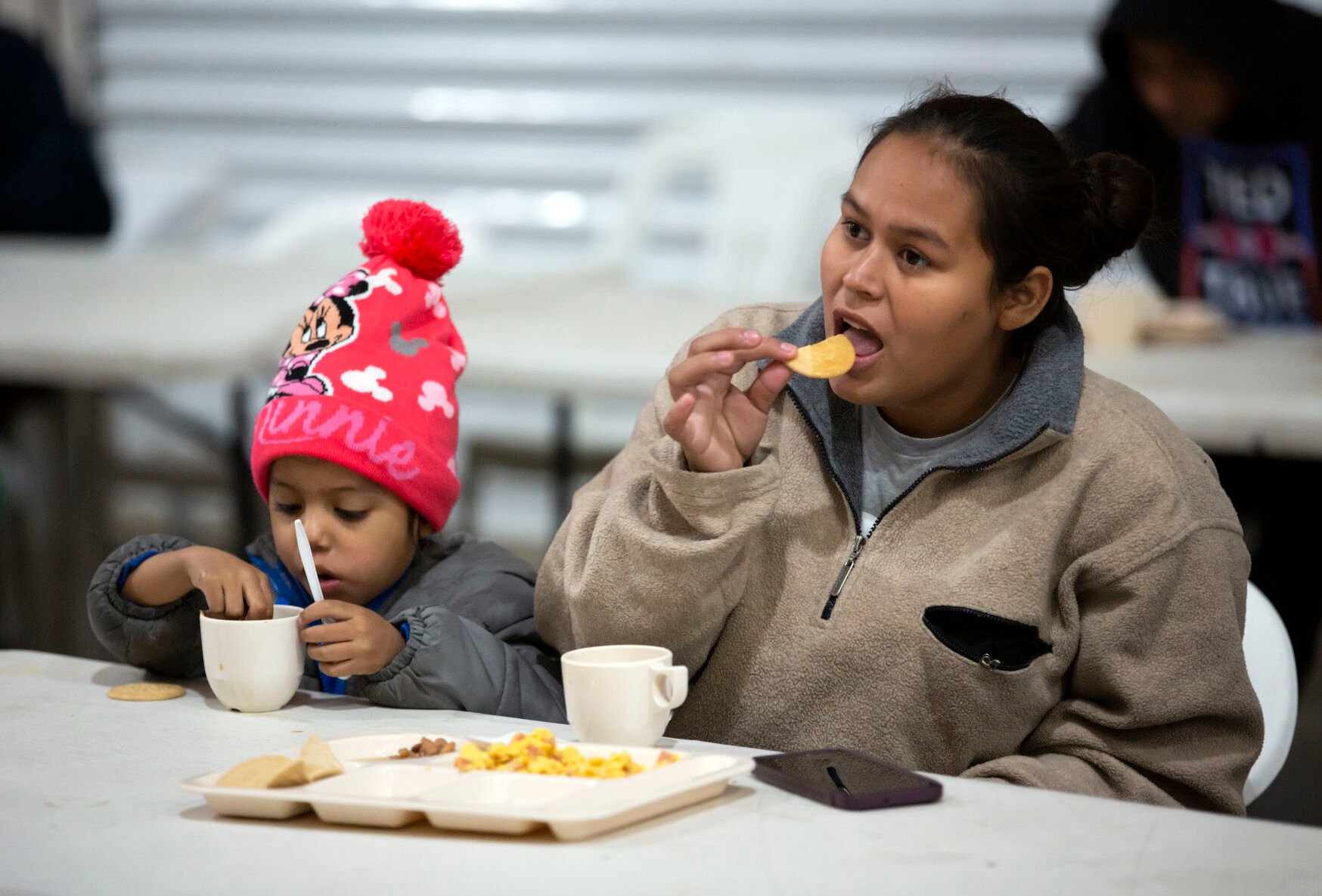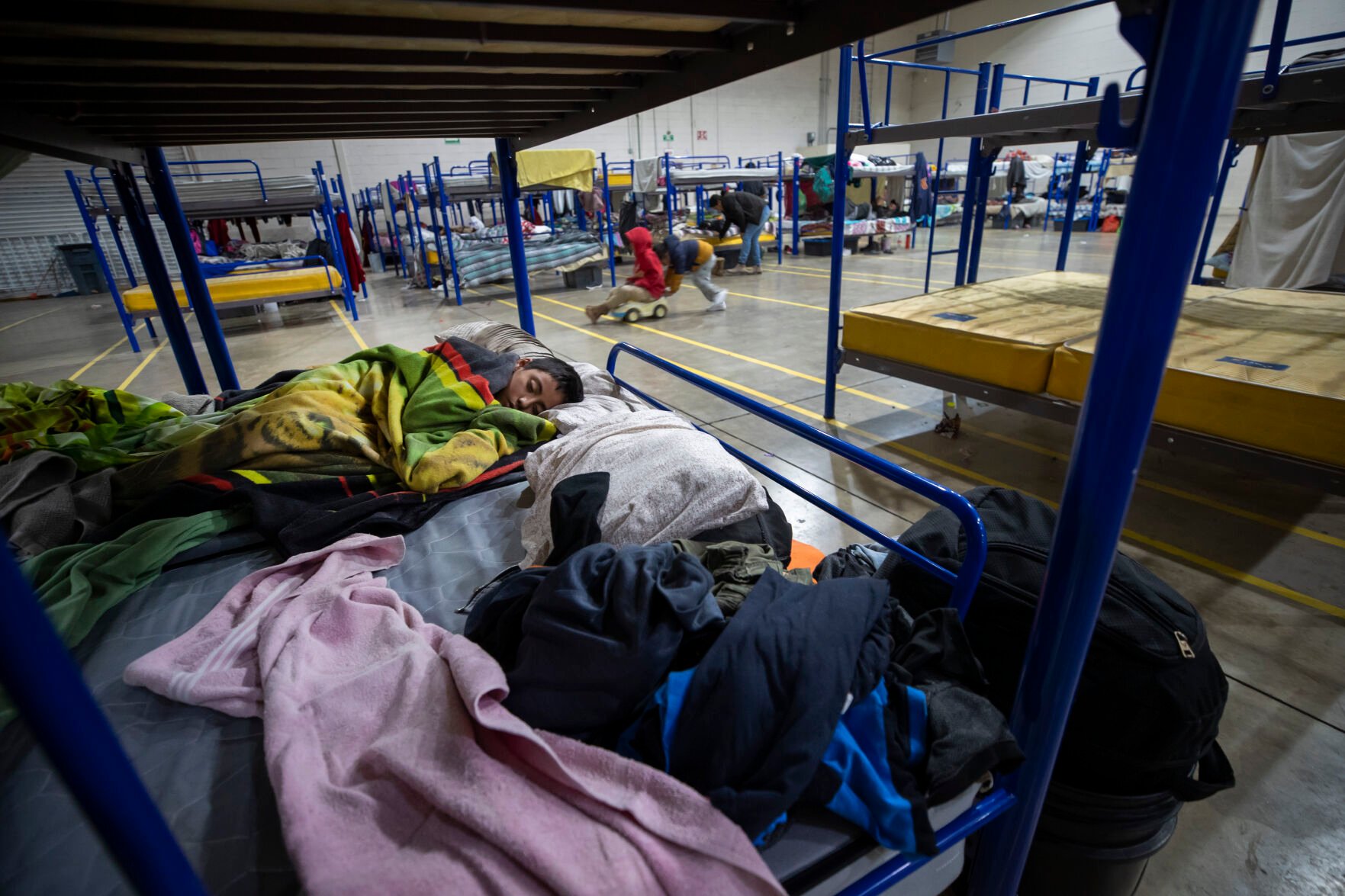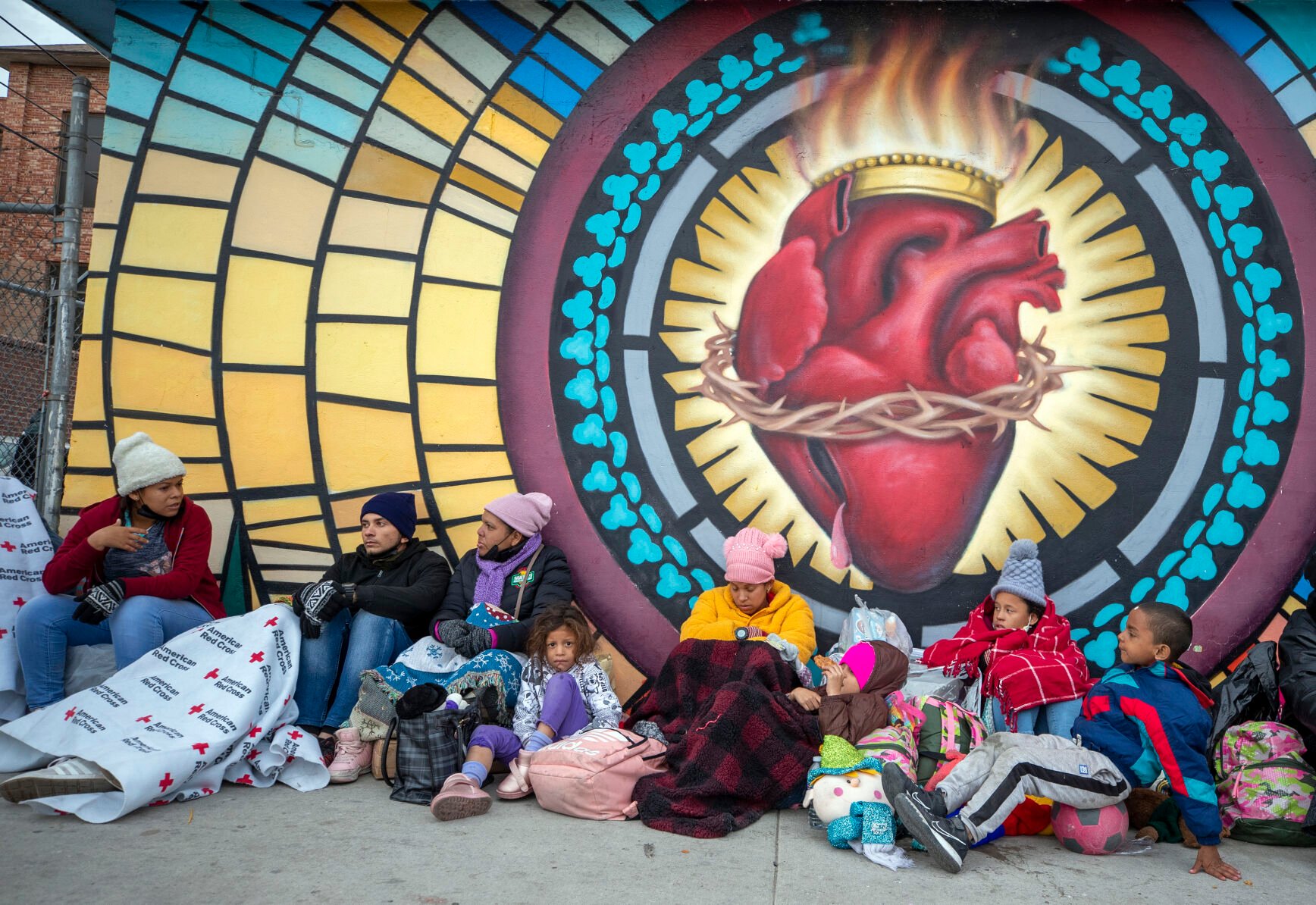CIUDAD JUAREZ, Mexico — Since he began volunteering two months ago for weekend shifts at a clinic in one of this border city’s largest shelters, Dr. Brian Elmore has treated about 100 migrants for respiratory viruses and a handful of more serious emergencies.
But it’s a problem he hasn’t yet managed to address that worries him the most: the worsening trauma that so many migrants carry after long journeys north that often involve witnessing murders and suffering from kidnappings and sexual assault.
“Most of our patients have symptoms of PTSD — I want to initiate a screening for every patient,” said Elmore, an emergency medicine doctor at Clinica Hope. It was opened this fall by the Catholic nonprofit Hope Border Institute with help from Bishop Mark Seitz of El Paso, Texas, which borders Juarez.
Doctors, social workers, shelter directors, clergy and law enforcement say growing numbers of migrants suffer violence that amounts to torture and are arriving at the U.S.-Mexican border in desperate need of trauma-informed medical and mental health treatment.
But resources for this specialized care are so scarce, and the network of shelters so overwhelmed by new arrivals and migrants who’ve been stuck for months by U.S. asylum policies, that only the most severe cases can be handled.
“Like a pregnant 13-year-old who fled gang rapes, and so needs help with child care and middle school,” said Zury Reyes Borrero, a case manager in Arizona with the Center for Victims of Torture, who visited that girl when she gave birth. “We get people at their most vulnerable. Some don’t even realize they’re in the U.S.”

Andres Leighton, Associated Press
A migrant mother and her child from El Salvador eat breakfast Dec. 18 at a government-run shelter in Ciudad Juarez, Mexico.
In the past six months, Reyes Borrero and a colleague helped about 100 migrants at Catholic Community Services’ Casa Alitas, a shelter in Tucson, Arizona, that in December was receiving about 700 people daily released by U.S. authorities and coming from countries as distinct as Congo and Mexico.
Each visit can take hours, as the case workers try to build a rapport with migrants and empower them, Reyes Borrero said.
Sarah Howell runs a clinical practice and a nonprofit treating migrant survivors of torture in Houston. When she visits patients in their new Texas communities, they routinely introduce relatives or neighbors who also need help with severe trauma.
“The estimated level of need is at least five times higher than we support,” said Leonce Byimana, director of U.S. clinical services for the Center for Victims of Torture, which operates clinics in Arizona, Georgia and Minnesota.
Most migrants are traumatized by what they left behind, as well as what they encountered en route, Byimana said. They need “first-aid mental health” as well as long-term care that’s even harder to arrange once they disperse from border-area shelters to communities across the country, he added.
Left untreated, trauma can escalate to where it necessitates psychiatric care instead of therapy and self-help, said Dylan Corbett, Hope Border Institute’s executive director.
Jesuit Refugee Service/USA, the U.S. branch of the global Catholic refugee agency, is planning to ramp up mental health resources in the coming weeks in El Paso, said its director, Joan Rosenhauer.

Andres Leighton, Associated Press
A migrant child sleeps Dec. 18 at a government-run shelter in Ciudad Juarez, Mexico.
All along the border, the most staggering trend has been the increase in pregnant women and girls, some younger than 15, who are victims of assault and domestic violence.
Volunteers and advocates are encountering so many of these survivors that they had to focus scarce legal, medical and shelter resources on helping them, leaving hundreds of other victims of political violence and organized crime to fend for themselves.
Service providers and migrants say the most dangerous spot on journeys is “la selva” — the Darien Gap jungle separating Colombia from Panama, crossed by increasing numbers of Venezuelans, Cubans and Haitians seeking safer lives in the U.S.
Natural perils only add to the risks of an area rife with bandits preying on migrants.
Loreta Salgado was months into her flight from Cuba when she crossed the Darien. “We saw many dead, we saw people who were robbed, people who were raped. We saw that,” she said, her voice cracking, in a migrant shelter in El Paso.

Andres Leighton, Associated Press
Migrants try to stay warm Dec. 18 while camping outside the Sacred Heart Church in El Paso, Texas.
Asked about “la selva,” some women just suck in their breath — and only later reveal having saved their daughters by speeding them along and getting raped themselves, or enduring strained relationships with their partners who were made to watch the assault, Howell said.
“I don’t think it’s the first rape that most women I’ve talked to have experienced,” Howell said. “But it’s the most violent and the most shameful, because it was in front of other people.”
In many cases, forensic evaluations at border clinics that document mental and physical abuse are crucial to migrants’ asylum cases, because often no other evidence is available for court proceedings, Byimana said. Asylum is granted to those who cannot return to their countries for fear of persecution on specific grounds, including sometimes very high, systemic levels of violence against women.
But it takes years for asylum cases to be decided in U.S. immigration court. A long wait for resolution can intensify the trauma that migrants experience, advocates say.
-
A survivor of the migrant trailer: ‘They couldn’t breathe’
Shutterstock
Photo Credit: spyarm / Shutterstock
With a foreign-born population of more than 44 million, the U.S. has the largest number of immigrants in the world. In fact, research from the Pew Research Center shows that the U.S. immigrant population accounts for one-fifth of the world’s migrants. While U.S. immigrants come from almost every country in the world, Mexico is the most common country of origin for the foreign-born population.
From the period of 1850 to 2020, when the most recent data is available, the foreign-born population share hit a high of 14.8% in 1900. From 1920 to 1980, the share of immigrants fell, dropping to a low of 4.7% in 1980. Until recently, the immigrant share of the population had been climbing and was at a near historic high in 2019 before the pandemic. The share of immigrants dropped slightly in 2020 to 13.5%, down from the 13.7% it had stood at for the last several years.
Shutterstock
Photo Credit: spyarm / Shutterstock
With a foreign-born population of more than 44 million, the U.S. has the largest number of immigrants in the world. In fact, research from the Pew Research Center shows that the U.S. immigrant population accounts for one-fifth of the world’s migrants. While U.S. immigrants come from almost every country in the world, Mexico is the most common country of origin for the foreign-born population.
From the period of 1850 to 2020, when the most recent data is available, the foreign-born population share hit a high of 14.8% in 1900. From 1920 to 1980, the share of immigrants fell, dropping to a low of 4.7% in 1980. Until recently, the immigrant share of the population had been climbing and was at a near historic high in 2019 before the pandemic. The share of immigrants dropped slightly in 2020 to 13.5%, down from the 13.7% it had stood at for the last several years.
-
A survivor of the migrant trailer: ‘They couldn’t breathe’
Accounting for 24.8% of the foreign-born population, Mexico claims the largest number of U.S. immigrants. The Chinese and Indian immigrant populations are also large, making up a collective 12.2% of the foreign-born population. Pew Research Center analysis of Census Bureau data shows that about one million immigrants arrive in the U.S. each year, and the most common region for new immigrants is now Asia, which recently surpassed Hispanic countries.
Accounting for 24.8% of the foreign-born population, Mexico claims the largest number of U.S. immigrants. The Chinese and Indian immigrant populations are also large, making up a collective 12.2% of the foreign-born population. Pew Research Center analysis of Census Bureau data shows that about one million immigrants arrive in the U.S. each year, and the most common region for new immigrants is now Asia, which recently surpassed Hispanic countries.
-
-
A survivor of the migrant trailer: ‘They couldn’t breathe’
While immigrants live in every U.S. state, some parts of the country have larger foreign-born populations than others. Over one-fourth of California’s population is foreign-born—mostly coming from Mexico—making California the top state for immigrants. New Jersey and New York also have large immigrant populations, with 22.7% and 22.4% of their populations being immigrants, respectively. Alternatively, Montana and West Virginia have very small immigrant populations, accounting for just 2.2% and 1.6% of their populations, respectively.
While immigrants live in every U.S. state, some parts of the country have larger foreign-born populations than others. Over one-fourth of California’s population is foreign-born—mostly coming from Mexico—making California the top state for immigrants. New Jersey and New York also have large immigrant populations, with 22.7% and 22.4% of their populations being immigrants, respectively. Alternatively, Montana and West Virginia have very small immigrant populations, accounting for just 2.2% and 1.6% of their populations, respectively.
-
A survivor of the migrant trailer: ‘They couldn’t breathe’
To determine the U.S. metropolitan areas with the largest immigrant populations, researchers at BackgroundChecks.org analyzed the latest data from the U.S. Census Bureau. The researchers ranked metros according to the foreign-born population share. Researchers also calculated the most common country of origin, the total foreign-born population, and the total population.
To improve relevance, only metropolitan areas with at least 100,000 people were included in the analysis. Additionally, metro areas were grouped into the following cohorts based on population size:
- Small metros: 100,000–349,999
- Midsize metros: 350,000–999,999
- Large metros: more than 1,000,000
Here are the metros with the largest immigrant populations.
To determine the U.S. metropolitan areas with the largest immigrant populations, researchers at BackgroundChecks.org analyzed the latest data from the U.S. Census Bureau. The researchers ranked metros according to the foreign-born population share. Researchers also calculated the most common country of origin, the total foreign-born population, and the total population.
To improve relevance, only metropolitan areas with at least 100,000 people were included in the analysis. Additionally, metro areas were grouped into the following cohorts based on population size:
- Small metros: 100,000–349,999
- Midsize metros: 350,000–999,999
- Large metros: more than 1,000,000
Here are the metros with the largest immigrant populations.
-
-
A survivor of the migrant trailer: ‘They couldn’t breathe’
-
A survivor of the migrant trailer: ‘They couldn’t breathe’
Shutterstock
Photo Credit: Andriy Blokhin / Shutterstock
- Foreign-born population share: 18.5%
- Most common country of origin: Mexico
- Total foreign-born population: 432,837
- Total population: 2,338,866
Shutterstock
Photo Credit: Andriy Blokhin / Shutterstock
- Foreign-born population share: 18.5%
- Most common country of origin: Mexico
- Total foreign-born population: 432,837
- Total population: 2,338,866
-
-
A survivor of the migrant trailer: ‘They couldn’t breathe’
Shutterstock
Photo Credit: f11photo / Shutterstock
- Foreign-born population share: 18.5%
- Most common country of origin: Mexico
- Total foreign-born population: 1,376,117
- Total population: 7,451,858
Shutterstock
Photo Credit: f11photo / Shutterstock
- Foreign-born population share: 18.5%
- Most common country of origin: Mexico
- Total foreign-born population: 1,376,117
- Total population: 7,451,858
-
A survivor of the migrant trailer: ‘They couldn’t breathe’
Shutterstock
Photo Credit: Songquan Deng / Shutterstock
- Foreign-born population share: 18.8%
- Most common country of origin: Colombia
- Total foreign-born population: 481,158
- Total population: 2,560,260
Shutterstock
Photo Credit: Songquan Deng / Shutterstock
- Foreign-born population share: 18.8%
- Most common country of origin: Colombia
- Total foreign-born population: 481,158
- Total population: 2,560,260
-
-
A survivor of the migrant trailer: ‘They couldn’t breathe’
Shutterstock
Photo Credit: Travellaggio / Shutterstock
- Foreign-born population share: 18.9%
- Most common country of origin: China
- Total foreign-born population: 918,197
- Total population: 4,854,808
Shutterstock
Photo Credit: Travellaggio / Shutterstock
- Foreign-born population share: 18.9%
- Most common country of origin: China
- Total foreign-born population: 918,197
- Total population: 4,854,808
-
A survivor of the migrant trailer: ‘They couldn’t breathe’
Shutterstock
Photo Credit: mahaloshine / Shutterstock
- Foreign-born population share: 19.2%
- Most common country of origin: Mexico
- Total foreign-born population: 754,455
- Total population: 3,928,498
Shutterstock
Photo Credit: mahaloshine / Shutterstock
- Foreign-born population share: 19.2%
- Most common country of origin: Mexico
- Total foreign-born population: 754,455
- Total population: 3,928,498
-
-
A survivor of the migrant trailer: ‘They couldn’t breathe’
Shutterstock
Photo Credit: Jon Bilous / Shutterstock
- Foreign-born population share: 21.1%
- Most common country of origin: Mexico
- Total foreign-born population: 970,476
- Total population: 4,600,396
Shutterstock
Photo Credit: Jon Bilous / Shutterstock
- Foreign-born population share: 21.1%
- Most common country of origin: Mexico
- Total foreign-born population: 970,476
- Total population: 4,600,396
-
A survivor of the migrant trailer: ‘They couldn’t breathe’
Shutterstock
Photo Credit: Virrage Images / Shutterstock
- Foreign-born population share: 22.1%
- Most common country of origin: Mexico
- Total foreign-born population: 492,617
- Total population: 2,228,866
Shutterstock
Photo Credit: Virrage Images / Shutterstock
- Foreign-born population share: 22.1%
- Most common country of origin: Mexico
- Total foreign-born population: 492,617
- Total population: 2,228,866
-
-
A survivor of the migrant trailer: ‘They couldn’t breathe’
Shutterstock
Photo Credit: ESB Professional / Shutterstock
- Foreign-born population share: 22.8%
- Most common country of origin: El Salvador
- Total foreign-born population: 1,425,904
- Total population: 6,250,309
Shutterstock
Photo Credit: ESB Professional / Shutterstock
- Foreign-born population share: 22.8%
- Most common country of origin: El Salvador
- Total foreign-born population: 1,425,904
- Total population: 6,250,309
-
A survivor of the migrant trailer: ‘They couldn’t breathe’
Shutterstock
Photo Credit: Sean Pavone / Shutterstock
- Foreign-born population share: 22.9%
- Most common country of origin: Mexico
- Total foreign-born population: 762,260
- Total population: 3,323,970
Shutterstock
Photo Credit: Sean Pavone / Shutterstock
- Foreign-born population share: 22.9%
- Most common country of origin: Mexico
- Total foreign-born population: 762,260
- Total population: 3,323,970
-
-
A survivor of the migrant trailer: ‘They couldn’t breathe’
Shutterstock
Photo Credit: Tomas Simkus / Shutterstock
- Foreign-born population share: 23.3%
- Most common country of origin: Mexico
- Total foreign-born population: 1,623,239
- Total population: 6,979,613
Shutterstock
Photo Credit: Tomas Simkus / Shutterstock
- Foreign-born population share: 23.3%
- Most common country of origin: Mexico
- Total foreign-born population: 1,623,239
- Total population: 6,979,613
-
A survivor of the migrant trailer: ‘They couldn’t breathe’
Shutterstock
Photo Credit: Lukas Uher / Shutterstock
- Foreign-born population share: 29.3%
- Most common country of origin: Dominican Republic
- Total foreign-born population: 5,652,129
- Total population: 19,261,570
Shutterstock
Photo Credit: Lukas Uher / Shutterstock
- Foreign-born population share: 29.3%
- Most common country of origin: Dominican Republic
- Total foreign-born population: 5,652,129
- Total population: 19,261,570
-
-
A survivor of the migrant trailer: ‘They couldn’t breathe’
Shutterstock
Photo Credit: yhelfman / Shutterstock
- Foreign-born population share: 30.7%
- Most common country of origin: China
- Total foreign-born population: 1,443,907
- Total population: 4,709,220
Shutterstock
Photo Credit: yhelfman / Shutterstock
- Foreign-born population share: 30.7%
- Most common country of origin: China
- Total foreign-born population: 1,443,907
- Total population: 4,709,220
-
A survivor of the migrant trailer: ‘They couldn’t breathe’
Shutterstock
Photo Credit: Sean Pavone / Shutterstock
- Foreign-born population share: 32.7%
- Most common country of origin: Mexico
- Total foreign-born population: 4,325,660
- Total population: 13,211,027
Shutterstock
Photo Credit: Sean Pavone / Shutterstock
- Foreign-born population share: 32.7%
- Most common country of origin: Mexico
- Total foreign-born population: 4,325,660
- Total population: 13,211,027
-
-
A survivor of the migrant trailer: ‘They couldn’t breathe’
Shutterstock
Photo Credit: thetahoeguy / Shutterstock
- Foreign-born population share: 39.1%
- Most common country of origin: China
- Total foreign-born population: 775,944
- Total population: 1,985,926
Shutterstock
Photo Credit: thetahoeguy / Shutterstock
- Foreign-born population share: 39.1%
- Most common country of origin: China
- Total foreign-born population: 775,944
- Total population: 1,985,926
-
A survivor of the migrant trailer: ‘They couldn’t breathe’
Shutterstock
Photo Credit: Just dance / Shutterstock
- Foreign-born population share: 40.9%
- Most common country of origin: Cuba
- Total foreign-born population: 2,504,666
- Total population: 6,129,858
Shutterstock
Photo Credit: Just dance / Shutterstock
- Foreign-born population share: 40.9%
- Most common country of origin: Cuba
- Total foreign-born population: 2,504,666
- Total population: 6,129,858



